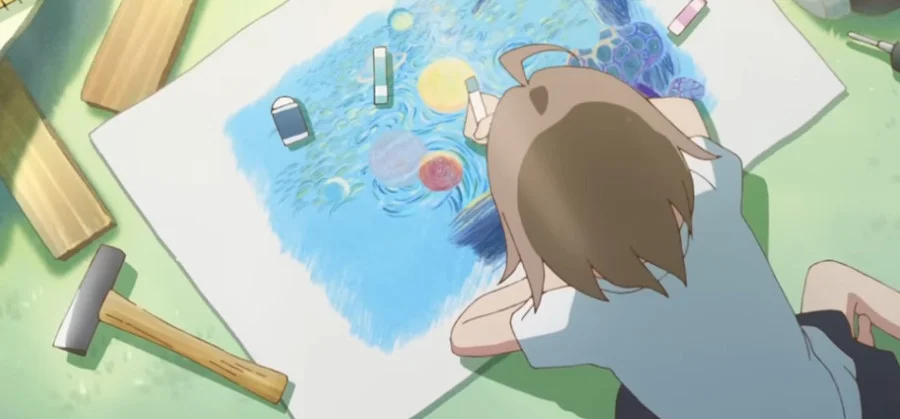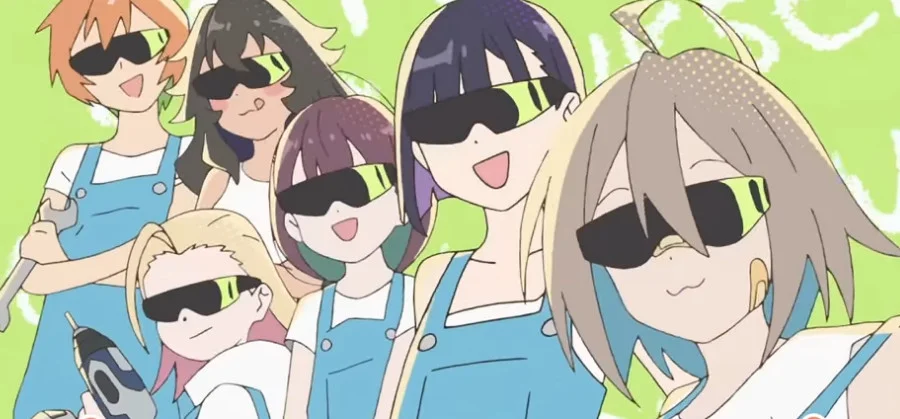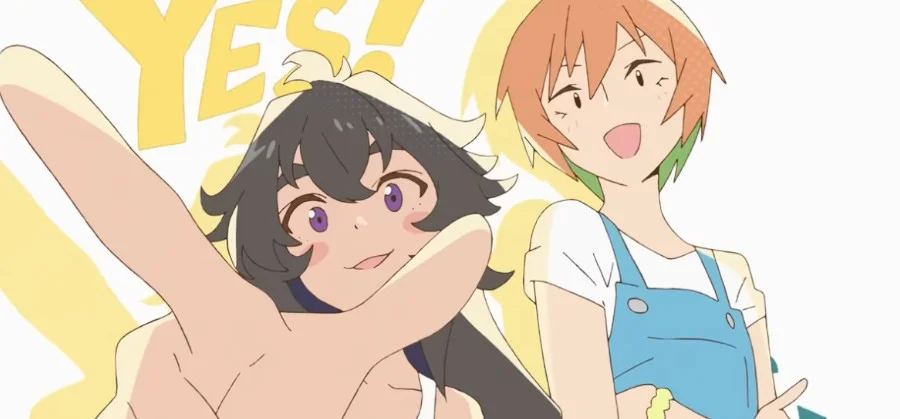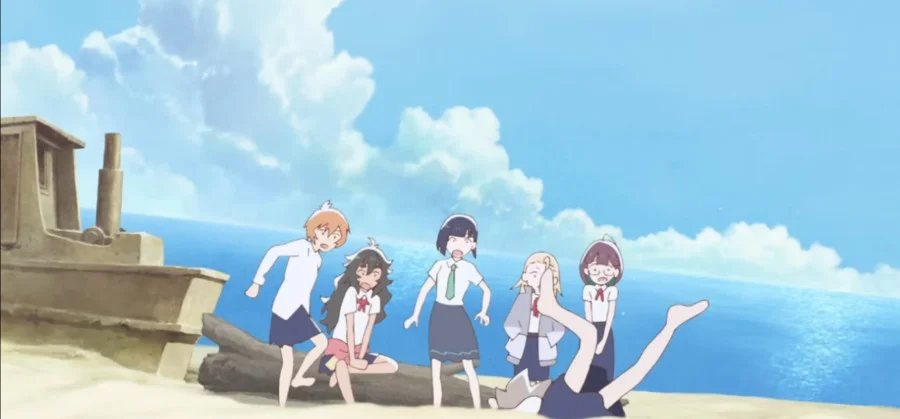If your particular thing was anime about cute girls with a special interest where you could very easily interpret pretty typical social engagement as in fact, boilingly obvious non-heterosexual romantic attachment, then this time last year, you were probably one of the many people extremely into the extremely good anime Bocchi The Rock. Funny, energetic, vibrant and extremely focused on its own particular aesthetic representations of a hyper-real relationship between the modern capitalist landscape and why we are people who are not suited to exist in it when there are far more important things you can do, relating to one another, and how difficult it is to say what you really mean when what you are really trying to do is to reach out to another person, someone you may have never met before or someone you may know deep as your own family and tell them hey, I want to be loved, by you.
And that obviously arch and highly poetic description of Bocchi that I’m using in a way that definitely elides some of the details and decentralises some of its more obvious themes is nonetheless also a summary of Do It Yourself!! an anime from the same season, same time slot, but a different channel, meaning that at least in the time when we make anime fight for our attention in capitalist landscapes, meant that Do It Yourself!! got to lose to Bocchi’s immense stardom, a fact that I am sure would leave Bocchi herself so overwhelmed she would hide in a box like a Metal Gear protagonist.
A box that could be made exquisitely well by the crew that make up Do It Yourself!!
Do It Yourself!! is a 13 episode anime focusing on the character Yua Serufu, who, yes, sounds like a Japanese girl saying ‘Yourself’ in English, that’s a joke the series itself makes, who is one of the most obviously untreated ADHD kids I’ve ever seen in an anime series. And I don’t just mean ‘this character’s existing narrative behaviour can be easily read this way,’ I mean things like the kid sleeping all the time, she has jittery hands, she has a hard time completing complex tasks with a lot of waiting, she doesn’t judge time well, but also she can hyperfocus, demonstrates a clear awareness of what she’s doing when she can be given room and time to concentrate. The result is that you have your typical dojikko traits, the ‘cute clumsy girl’ but there’s a bit more under there, too. What’s more, Serufu is a shockingly kind character, able to absorb criticism and attempts from people to be mean to her, because she doesn’t care about that and is much more focused on ways people are good.
At its heart, Do It Yourself!! is just another Cute Girls Doing Cute Things anime, and the Cute Things in this case is industrial arts and crafts. The typical experience of Do It Yourself!! is turning on an episode and watching as some nicely animated, sweet characters who like one another, engaging in the timeless narrative framework of man vs man except the ‘vs man’ is stuff like ‘not having a nice bench.’ It’s in that ‘healing’ genre I bring up from time to time, y’know, iyashikei, a word I definitely don’t need to keep looking up every time I use it. There’s never anything really that bad happening in the story, you’re not going to be left wondering ‘oh no, how are these goofballs going to get out of this now,’ and there’s no tense twists or surprises. You watch the opening of the anime and it shows you six characters hanging out and doing stuff together, and then, turns out, the anime is about those six characters joining up and hanging out and doing stuff. Together!
No, you’re not being offered a complex narrative or even a will-they, won’t-they narrative for those of you prepping your yuri goggles. My most basic of experiences of Do It Yourself is a lovely boppy opening, twenty minutes of characters learning about a new way to do things or about a new friend who can join their group, and the ongoing project of building a rad-as-hell treehouse to draw attention to their club. That club, by the way, has a central goal of basically ‘doing stuff in a shed,’ so if you’re at all familiar with shed culture, yeah, it’s that. It’s the kind of hand-crafted load-bearing stuff that you can make when you’ve got a ventilated space where it’s okay if you get wood shavings over everything.
Faced just on those merits, Do It Yourself!! is a really great little unit of chill, gentle anime experience and one I recommend, especially if you find other fare in the same space a little too frustrating for attempts to manifest tension or somehow construct a half-hearted quit-and-rejoin narrative mid-way through. It’s a nice show!
One thing about how the anime looks is that for all this anime has a really lovely low-detail style for all the characters, with almost no shading and even subtle eye styles, whenever they depict a specific real world type of tool then the detailing goes through the roof. I showed a friend screencaps of the characters holding tools and they were able to show me the sales pages for those tools on various Japanese websites. It’s almost like a flex, a deliberate demonstration that hey! It’s not like we can’t do things that are difficult here!
It’s not like Do It Yourself!! is completely bereft of deeper things to consider, even setting aside its comically poorly timed release. There’s an interesting vision of a modestly forward future; a time a little bit ahead from now, where the public transport is auto-driving, reliable, and clean, where delivery drones are a nearly constant presence in the sky, and where expensive, extremely wealthy schools teach using entirely digital interfaces and get students involved in things like 3D printing on the first day.
It’s in this future that we see some hints of how an old culture with traditional reasons for being changes slowly. In Do It Yourself!! there’s an invisible ink about the two schools that Serufu and her neighbour attend. One of them is a big fancy towering rich school with metal detectors and helicopter pads, and the other is much more like a typical, current school without access to that kind of infrastructural support, and the two exist in basically the same city blocks. It speaks to zoning laws, the way that real estate is hard to come by in Japan, and the way that building up is the best way to build more, even if it means the richer school swallows the space around the poorer one.
There’s also a lovely potential reading of the ending which I’m… cautious about.
See, when I spoke to a friend about Do It Yourself!! she said ‘this is an anime that Says It,’ and so, when I watched it, I was waiting for a moment when a girl told another girl ‘I am in love with you’ or at least said something a little unambiguous. We’ve been getting those lately, that’d be cool. What we got instead, though, was an ending where I felt my big was very much am’d.
… Except…
I was watching the show in English, and the official English version of Do It Yourself!! is … kind of weirdly flaky? There are some points where Serufu is described as being inconsiderate and selfish in a sentence where I feel it’d be much more likely to mean thoughtless. It’s not like the Serufu we see in the series is ever selfish. There’s no subtitles on the main theme, which feels a bit incomplete. Also in a technology landscape that’s… y’know, pretty complex by the now, one of the main characters describes her first day of school as being about 3d printing organs, which seems a marked jump from the now, but, I can imagine it’s very easy to confuse the wording for that phrase from I 3d printed a stent usable in an organ. That’s a real thing, and a little more ‘first day of school,’ since a stent is a great design for something complicated to demonstrate how 3d printing resolution works.
Does it show that I teach people to use 3d printers.
Anyway.
When there are these little creeping considerations, I found myself wondering if the subtitlers were bigger cowards than the original authors, at least about the resolution of the last episode. It’s not subtle about what it probably means and if you’re used to the genre foibles of but-we-won’t-say-it yuri anime, yeah, it’s not hard to see this as one of the more firmly declarative versions of it, and if you’re more familiar with Japanese (or working from a different translation), it might be much more clear.



